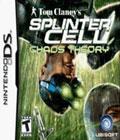Genre: Action
Publisher: Ubisoft
Developer: Ubisoft
Release Date: March 28, 2005
Buy 'SPLINTER CELL: Chaos Theory':
Xbox | GameCube | PC | PlayStation 2
Sometimes, it takes a while to get things right.
I’ve never been a big fan of Splinter Cell. I started playing the series with Pandora Tomorrow, which had a deeply frustrating singleplayer mode coupled with an innovative and decidedly addictive multiplayer game. There was fun to be had with both it and its predecessor, but I seem to be a glass is half-empty kind of guy. When I think Pandora Tomorrow, I don’t think epic stealth adventure, I think of psychic guards who can put a full clip through my ass from a hundred feet away, in the dark, because their batlike sonar picked me up.
Splinter Cell: Chaos Theory is the latest installment of the series, made by the original game’s team, and it’s a serious improvement in any way you care to name, from gameplay to its newly, eerily realistic graphics. The singleplayer mode’s been drastically reworked to favor exploration and creativity over trial and error, the spies-vs.-mercenaries multiplayer mode’s balance has been tweaked, and a new cooperative multiplayer’s been thrown into the mix. This is the first game in the series that I’d actually feel comfortable recommending to people.
In the singleplayer mode, you once again play as Sam Fisher, the covert-ops agent of the secret military organization Third Echelon. A mission to rescue an American computer scientist quickly snowballs, until you’re hipdeep in international conspiracies, doublecrosses, and a scheme to bring about a second Korean War. To defuse the situation, Fisher will have to infiltrate enemy strongholds from Panama City to Tokyo, doing what he does.
Fisher himself has been working out and practicing his marksmanship; he’s got some new techniques, and he can now actually hit distant targets with his rifle or pistol. Most of his old equipment and moves make a return, from his cool but usually useless split jump to the assortment of special darts you can load into his rifle. That arsenal’s been augmented by a new upside-down chokehold, available when you’re hanging from a pipe and someone passes by beneath you, and a knife.
The knife changes Chaos Theory’s gameplay more than you’d think. It replaces Fisher’s underpowered elbow strike with an instantly fatal close-quarters stab or slash, and lets you cut through tent walls or plastic sheeting to create your own entrance. Fisher can also instantly KO enemies by running up and pulling the Left trigger. You no longer have to methodically slap chokeholds or use up shockers on every guard in an area; as a matter of fact, most of your arsenal is almost unnecessary. It goes a long way towards perpetuating the illusion of Fisher, and thus the player, as a truly elite agent.
Another helpful addition is a meter that measures the ambient sound of an area, as well as the amount of sound you’re making. As long as you’re not louder than what’s going on around you, you won’t tip off enemies to your presence. It’s a great addition, and honestly, it’s much more useful than the often pointless light meter (which should have two settings: “Invisible” and “Screwed”).
The best change, though, is Chaos Theory’s new approach to level design. Past Splinter Cells dropped you into stages that were all essentially linear, with one proper and several improper ways of doing things. Chaos Theory takes a new approach, letting you find multiple ways of entering most areas and thus multiple ways of accomplishing most of your goals.
For example, in a later level, you’re supposed to grab some hard drives out of a sealed vault. You can head into the building via the front door, wait for some enemy soldiers to blow the door, take them out, and steal the drives; or you can climb a nearby building, enter the vault via its ventilation system, swipe the drives, and leave before anyone knows you’re there. In past games, you would’ve been forced into one approach. Now you can opt for either. Other stages have even more options.
Your objectives have also softened a bit. Guards can no longer trigger an alarm within nanoseconds of seeing you; now they have to run over and hit one of the dozen or so conveniently located switches throughout a given level. Further, Lambert has chilled out. Rather than ending your mission instantly upon your discovery or a set number of raised alarms, he’ll simply complain a lot and your end-of-level ranking will be penalized. If you’re like me, and you walked away from Pandora Tomorrow with the phrase “You are paid to be invisible” etched on your forebrain, this comes as a welcome relief.
Singleplayer’s only one part of Chaos Theory, and it’s probably not the part that most of you are interested in. The multiplayer mode from Pandora Tomorrow has made a comeback, and it’s just as addictive as before. The spies have gained an active camoflauge gadget, which conceals you as long as you’re standing still and unarmed, while the mercenaries are newly equipped with lethal poison mines and a 180-degree melee move, perfect for conking out spies who thought they had the drop on you. They’ve gone the extra mile to even out the balance between the teams, which is great for those of us, such as myself, who spent their multiplayer time in PT being used as a taser target.
The co-op mode, by comparison, is great fun either online or off, but it’s a little limited. I’m sure they’ll offer more levels eventually as downloads over Live, but for right now, four stages doesn’t quite seem like enough.
Chaos Theory isn’t without a few problems. Enemies shake off flash grenades way too quickly, gas grenades are totally worthless, and there’s no way for a mercenary to prevent himself from being used for a spirited game of kickball by a spy who gets the drop on him (the infamous taser-choke-taser-choke idiot maneuver; a way to break a hold would be dandy).
The biggest problem I’ve got with the game is still with singleplayer and co-op. Much like the last few Splinter Cell games, the enemies seem to be able to instantly extrapolate your position from your gunfire, regardless of your concealment, positioning, or what they’re doing at the time. I’ve shot out a light bulb from four stories above a guy’s head, using a weapon that generates no muzzle flash, and he still figured out exactly where I was. At another point, I was completely concealed, and a guy with a machine gun noticed me because I dropped his buddy with a sticky shocker from one floor up and about forty feet away. It’s asinine.
 If the series continues like this, I’m sure they’ll fix these last few problems in Splinter Cell 4. For now, though, they’re here, they shouldn’t be, and they’re frustrating anomalies in a package that’s otherwise very polished.
If the series continues like this, I’m sure they’ll fix these last few problems in Splinter Cell 4. For now, though, they’re here, they shouldn’t be, and they’re frustrating anomalies in a package that’s otherwise very polished.
If you don’t like stealth games, this won’t change your mind. If you don’t like Splinter Cell, check out Chaos Theory. Before I played this, I didn’t care for the series either, and I’m surprised that I like it as much as I do.
Score: 9.6/10
More articles about Splinter Cell Chaos Theory











 In Tom Clancy’s Splinter Cell Chaos Theory, the year is 2008. Citywide blackouts, stock exchange sabotage, electronic hijacking of national defense systems: This is information warfare. To prevent such attacks, operatives must infiltrate hostile territory and aggressively collect critical intelligence, getting closer than ever to enemy soldiers.
In Tom Clancy’s Splinter Cell Chaos Theory, the year is 2008. Citywide blackouts, stock exchange sabotage, electronic hijacking of national defense systems: This is information warfare. To prevent such attacks, operatives must infiltrate hostile territory and aggressively collect critical intelligence, getting closer than ever to enemy soldiers.






































